Lewin Benjamin (ed.) Genes IX
Подождите немного. Документ загружается.

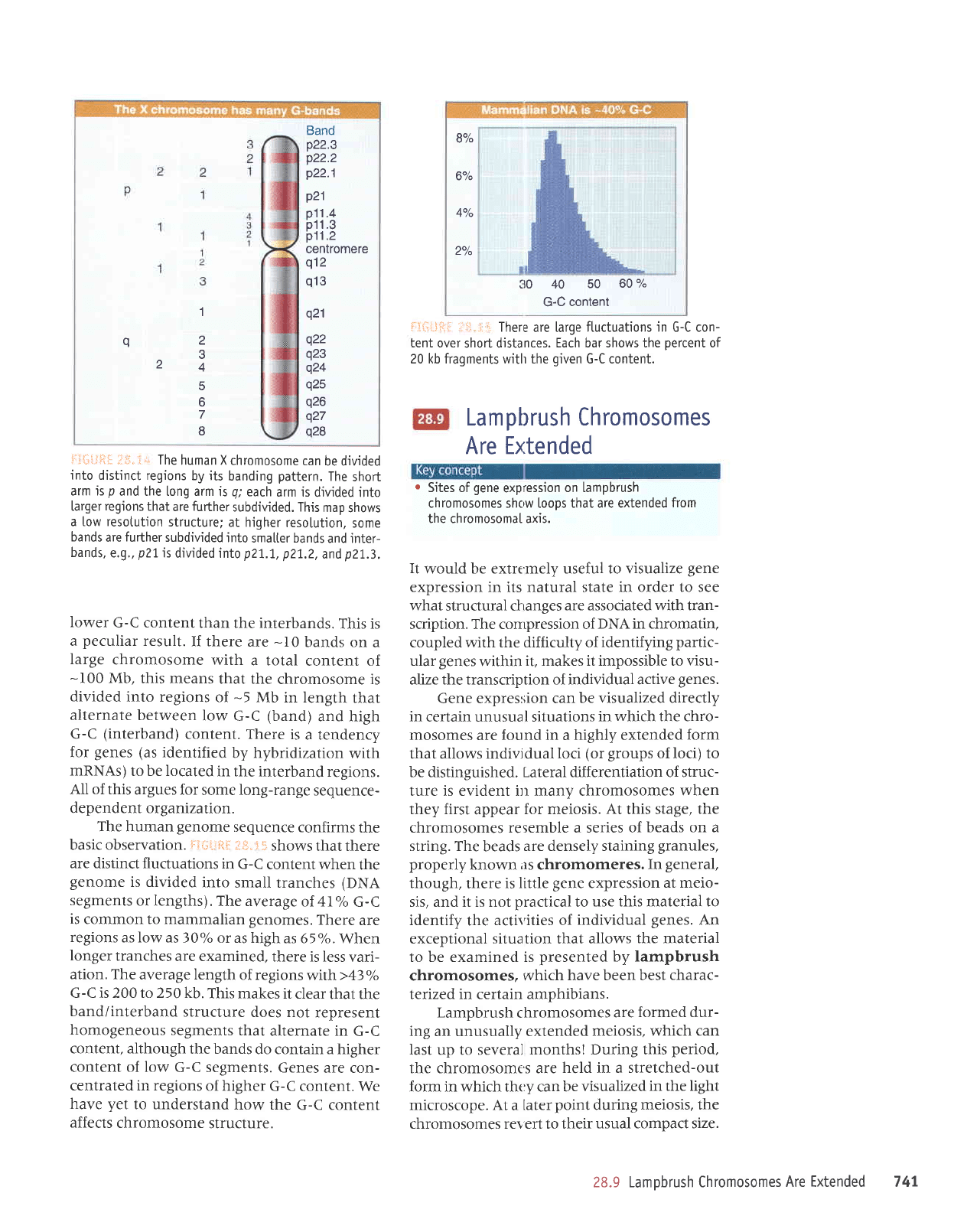
Band
p22.3
p22.2
p22.1
p21
p11.4
p11
.3
p11.2
cenlromere
q12
q13
q21
q22
q23
q24
q25
q26
q27
q28
1
q2
\'
24
5
6
I
8
8%
6"k
4o/o
2Y"
30 40
50
60%
G-C
content
f iiri.ifii:
ili:l.t
rr
The
human X
chromosome
can
be divided
into distinct regions
by its
banding
pattern.
The
short
arm
js
p
and the long arm
is
q,'
each
arm is
djvjded into
larger
regions
that
are
further
subdivided. This
map
shows
a [ow resotution
structure;
at higher
resolution,
some
bands
are
further
subdivided
into
smatter bands
and inter-
bands,
e.9.,
p21
is
divided into
p21.1.,
p27.2,
and
p21,.3.
Iower
G-C content
than the interbands.
This is
a
peculiar
result.
If there
are
-10
bands on
a
large
chromosome
with
a total
content of
-100
Mb,
this means
that the
chromosome is
divided
into regions
of
-5
Mb in length
that
alternate
between
low
G-C
(band)
and high
G-C
(interband)
content.
There is
a tendency
for
genes (as
identified
by hybridization
with
mRNAs)
to be located
in the
interband regions.
All of this
argues for
some long-range
sequence-
dependent organization.
The human
genome
sequence
confirms
the
basic observation.
:'i*r-i"!ti;
;*.::.i
shows
that there
are distinct fluctuations
in
G-C
content when
the
genome
is divided
into
small tranches
(DNA
segments
or lengths).
The ave rage
of 4lo/o
G-C
is
common to mammalian genomes.
There
are
regions
as low as
30o/o or as
high as 650/o.When
longer
tranches
are examined,
there is less
vari-
ation. The
average length
of regions
with>4joh
G-C is 200 to 250 kb.
This makes
it clear
that tne
band/interband
structure
does not
represent
homogeneous
segments
that
alternate in
G-C
content, although
the bands
do contain a higher
content of low
G-C segments.
Genes
are con-
centrated in regions
of higher
G-C content.
We
have
yet
to understand
how the
G-C content
affects
chromosome
structure.
ai{;iJfii:
llir.ili
There
are large
ftuctuations
jn
G-C con-
tent over
short djstances.
Each bar shows the
percent
of
20 kb fragments with the
given
G-C content.
Lampbrush Chromosomes
Are Extended
r
Sites of
gene
expression
on lampbrush
chromosomes shc,w loops that are extended
from
the chromosomaI axis.
It
would be extremely useful to visualize
gene
expression
in its natural state
in order to see
what
structural chranges
are associated with tran-
scription. The couLpression of
DNAin chromatin.
coupled with the difficulty of
identifying
partic-
ular
genes
within
it, makes it impossible to visu-
alize the transcription of individual active
genes.
Gene expres:;ion can
be
visualized
directly
in
certain unusual situations
in
which
the chro-
mosomes
are found
in
a
highly extended form
that allows indivjdual loci
(or groups
of loci) to
be distinguished. Lateral differentiation of struc-
ture is evident h many chromosomes
when
they first
appear
for meiosis.
At
this stage,
the
chromosomes resemble a series of
beads on a
string. The
beads
are densely staining
granules,
properly
known;rs chromomeres.
In
general,
though,
there
is little
gene
expression
at meio-
sis, and it is not
practical
to
use this material to
identify
the
activities of
individual
genes.
An
exceptional situation that allows
the material
to be examined is
presented
by lampbrush
chromosomes, which
have been best
charac-
terized in certain amphibians.
Lampbrush
chromosomes
are
formed dur-
ing an unusually extended
meiosis, which
can
last up to several months!
During this
period,
the chromosomc's are
held in a stretched-out
form in which thr:y can be
visualized
in the light
microscope. At
a
later
point
during
meiosis, the
chromosomes re\.ert to their
usual compact size.
28.9 Lampbrush Chromosomes
Are Extended 741
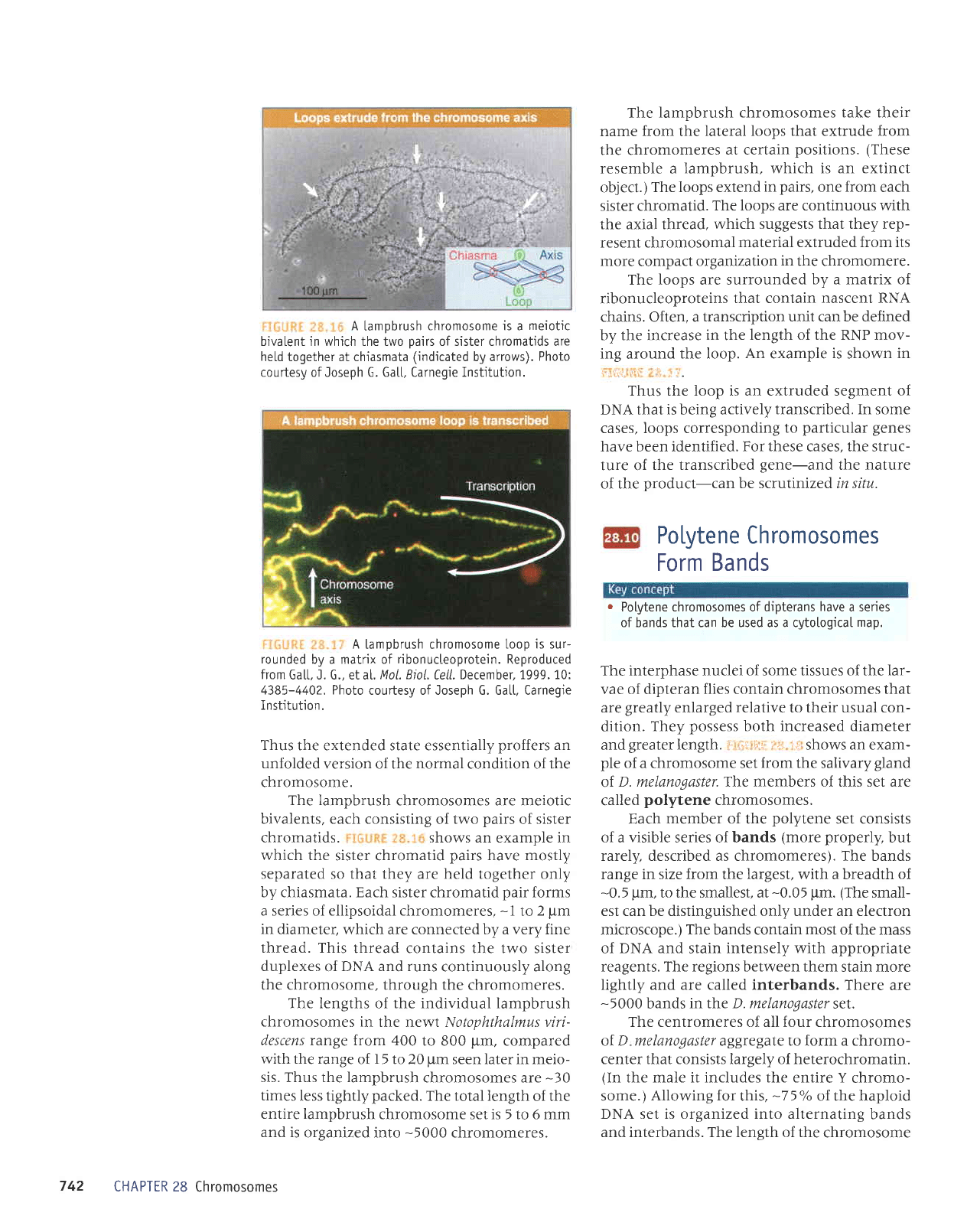
A
Lampbrush
chromosome is a
meiotic
bivaLent in which the two
Dairs
of sister chromatids are
heLd together at chiasmata
(indicated
by arrows).
Photo
courtesy
of Joseph
G. Gatt, Carnegie Institution.
A
[ampbrush chromosome
loop is sur-
rounded
by a matrix of
ribonucteoprotein.
Reproduced
from
GatL, J. G., et al.
MoL. BioL.
Cell.
December, 1999. 10:
4385-4402. Photo
courtesy of Joseph G. GaLt, Carnegie
Institution.
Thus
the extended state essentially
proffers
an
unfolded
version of the normal condition of the
chromosome.
The lampbrush
chromosomes are meiotic
bivalents, each consisting
of
two
pairs
of
sister
chromatids. shows an example in
which the
sister chromatid
pairs
have mostly
separated
so
that they
are
held
together only
by chiasmata. Each sister
chromatid
pair
forms
a series of ellipsoidal chromomeres,
-l
to
2
pm
in
diameter, which are connected by a very fine
thread. This
thread contains the two sister
duplexes
of
DNA and runs
continuously along
the chromosome, through the
chromomeres.
The iengths
of
the individual lampbrush
chromosomes
in the newt Notophthalmus viri-
descens range from 400
to 800
pm,
compared
with the range
of
l5
to 20
pm
seen later in meio-
sis. Thus the lampbrush
chromosomes are
-30
times
less tightly
packed.
The total length
of the
entire lampbrush
chromosome set is 5 to 6 mm
and is
organized into
-5000
chromomeres.
CHAPTER 28
Chromosomes
The
lampbrush chromosomes take their
name from the
lateral loops that extrude from
the chromomeres
at certain
positions. (These
resemble a lampbrush,
which is an extinct
object.)
The loops extend
in
pairs,
one
from
each
sister chromatid.
The loops are continuous with
the axial thread,
which suggests that they rep-
resent chromosomal
material extruded from its
more
compact
organization
in
the chromomere.
The loops are surrounded
by a matrix of
ribonucleoproteins
that contain nascent RNA
chains. Often, a
transcription unit can be defined
by the increase
in
the
length of the RNP mov-
ing
around
the loop.
An
example
is
shown
in
j,l,ri,ijl
r]:i
Lr.
Thus the loop is an extruded segment of
DNA that is being actively
transcribed. In some
cases, loops corresponding
to
particular genes
have been identified.
For these
cases, the struc-
ture of
the transcribed
gene-and
the nature
of the
product-can
be scrutinized in situ.
Polytene Chromosomes
Form Bands
.
Polytene chromosomes of dipterans
have
a series
of bands that can be used as a cytotogicaI
map.
The interphase nuclei of some tissues of the lar-
vae oI dipteran
flies contain chromosomes that
are
greatly
enlarged
relative
to their usual con-
dition.
They
possess
both increased diameter
and
greaterlength.
;i,r.ri-ri;:
r.; :r
shows an exam-
ple
of a chromosome set
from
the salivary
gland
of.
D. melanogaster. The members of this set are
called
polytene
chromosomes.
Each member of the
polytene
set consists
of a
visible
series of bands
(more
properly,
but
rarely, described as chromomeres). The bands
range in size from the largest, with a breadth of
-0.5
pm,
to the smallest, at
-0.05
pm.
(The
small-
est can be distinguished only under an electron
microscope.) The bands contain most of the mass
of
DNA and
stain
intensely with
appropriate
reagents. The regions between them
stain more
lightly and are called interbands. There
are
-5000
bands
in the D. melanlgaster
set.
The centromeres of all four chromosomes
of. D melanogaster aggregate to form a chromo-
center that consists largely of heterochromatin.
(In
the male it includes the entire Y
chromo-
some.)
Allowing for
this,
-75o/o
of the haploid
DNA set is organized into alternating
bands
and interbands. The length of the
chromosome
742
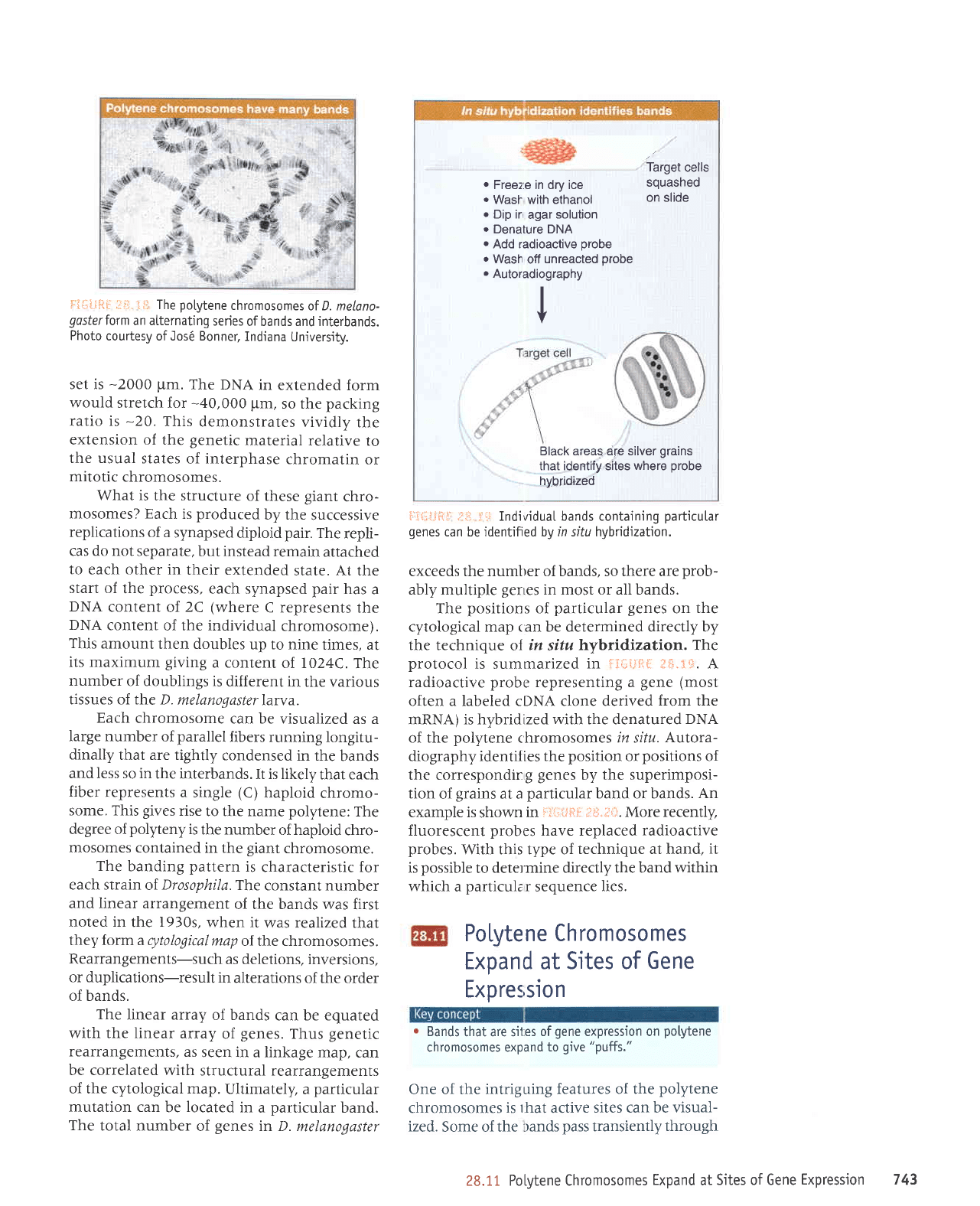
iri{il-tfti:
lii.lri: The
polytene
chromosomes
of D. melono-
gasterform
an atternating
series
ofbands and interbands.
Photo
courtesy ofJos6 Bonner,
Indiana
University.
set is
-2000
pm.
The DNA
in
extended form
would
stretch for
-40,000
pm,
so the
packing
ratio is
-20.
This
demonstrates
vividly
the
extension of the
genetic
material
relative to
the usual
states
of
interphase
chromatin
or
mitotic
chromosomes.
What is
the structure
of these giant
chro-
mosomes? Each
is
produced
by the
successive
replications
of a
synapsed
diploid
pair.
The
repli-
cas do not
separate, but instead
remain
attached
to
each other in
their extended
state. At the
start of
the
process,
each synapsed
pair
has
a
DNA
content
of
2C
(where
C represents
the
DNA
content
of the individual
chromosome).
This
amount
then doubles
up to
nine times, at
its maximum giving
a content
of 1024C.
The
number
of doublings is
different
in the various
tissues of the D.
melanogasterlarva.
Each
chromosome
can be visualized
as a
large number
of
parallel
fibers running
longitu-
dinally
that are tightly
condensed
in the
bands
and less so in
the interbands.
It is likely
that each
fiber
represents
a single
(C)
haploid
chromo-
some. This
gives
rise
to the name
polytene:
The
degree of
polyteny
is
the number
of haploid
chro-
mosomes contained
in the
giant
chromosome.
The
banding
pattern
is
characteristic for
each strain
of
Drosophila.
The
constant number
and linear arrangement
of the bands was
first
noted in
the
I930s,
when
it was realized
that
they form aqttologicalmap
olthe chromosomes.
Rearrangements-such
as
deletions, inversions,
or duplications-result
in
alterations
of the order
of bands.
The
linear array
of bands
can be equated
with the linear
array
of
genes.
Thus
genetic
rearrangements,
as
seen in a linkage
map, can
be correlated with
structural rearrangements
of the cytological map.
Ultimately,
a
particular
mutation can
be
located
in
a
particular
band.
The
total number
of
genes
in D.
melanogaster
.
Freez:e in dry ice
r
Wasl- with ethanol
.
Dip ir
agar
solution
o
Denature DNA
.
Add radioactive
probe
o
Wasl-
ofi
unreacted
probe
.
Autoradiography
I
T
V
iarget
cells
squashed
on slide
Black areas a1e silver
grains
that identify sites
where
probe
hyhridized
ll:ii:
i.J
fi f ,,il:i,,:
ir
Indi viduaI ba nds contai
ni
n
g particutar
genes
can be identified by in situ hybridization.
exceeds the numller of bands, so there are
prob-
ably multiple
gerles
in most or all bands.
The
positions
of
particular genes
on
the
cytological map
(
an be determined directly by
the technique
oI
in
situ
hybridization. The
protocol
is summarized
in
4iiii!.i*{
i:*:.51i}. A
radioactive
probe
representing a
gene (most
often a labeled cDNA clone derived
from the
mRNA) is hybridized
with
the denatured
DNA
of the
polytene
(hromosomes
in situ.
Autora-
diography identilies the
position
or
positions
of
the correspondirg
genes
by
the
superimposi-
tion
of
grains
at a
particular
band or bands.
An
example is
shown
in
iit,l,f 'rtii ;:*",iJi:l. More recently,
fluorescent
probes
have replaced
radioactive
probes.
With this type of
technique at hand,
it
is
possible
to
determine directly the band
within
which
a
particule
r
sequence
lies.
Polytene Chromosomes
Expand at Sites of
Gene
Expres;sion
.
Bands
that are sil.es
of
gene
expression on
polytene
chromosomes expand
to
give
"puffs."
One of the intriguing
features of the
polytene
chromosomes
is t hat
active
sites can be visual-
ized.
Some of the rands
pass
transiently
through
28.11 Potvtene Chromosomes
Expand
at
Sites of Gene
Expression 743
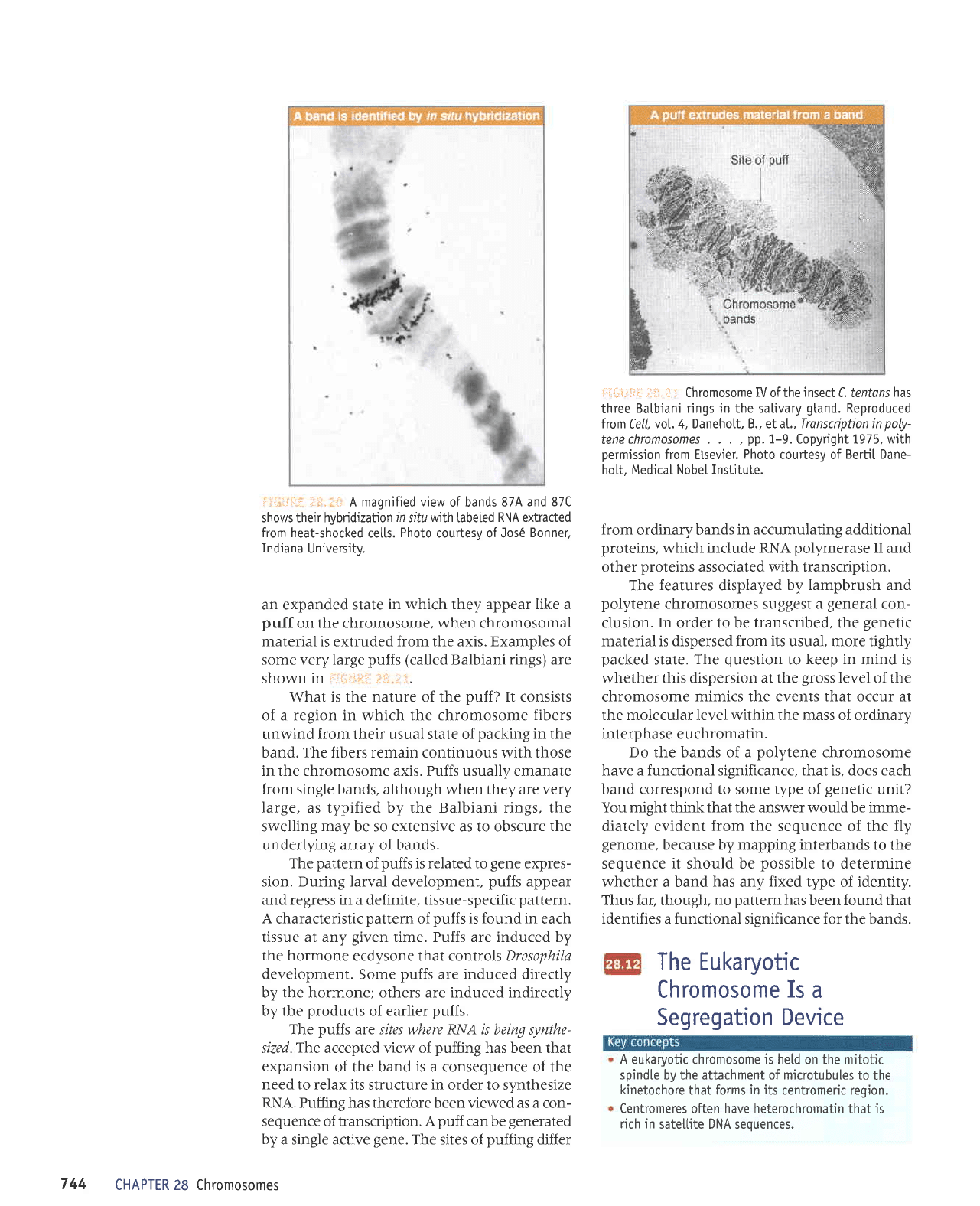
;'.:
::i.:i .::..:..
A magnified
view
of bands 87A
and 87C
shows their hybridization
rn
sifu
with Labeted RNA extracted
irom heat-shocked
ce[ts.
Photo
courtesv ofJos6
Bonner,
Indiana
Universitv.
an expanded state
in which they appear like a
puff
on the chromosome, when chromosomal
material is
extruded
from the axis. Examples of
some very large
puffs
(called
Balbiani rings) are
shown in
:::i:r;iii
'li::
j j
'
What is
the
nature
of
the
puff?
It consists
of a region in which the chromosome
fibers
unwind from their usual state of
packing
in the
band. The fibers remain continuous with those
in the chromosome axis. Puffs usually emanate
from single bands, although when they are
very
.arge, as typified by the Balbiani rings, the
swelling
may
be so extensive as to obscure
the
underlying array of bands.
The
pattern
of
puffs
is related to
gene
expres-
sion. During larval development,
puffs
appear
and regress in a definite, tissue-specific
pattern.
A
characteristic
pattern
of
puffs
is found in
each
tissue at any
given
time. Puffs are induced by
the hormone
ecdysone that controls Drosophila
development. Some
puffs
are induced directly
by the hormone; others are induced indirectly
by the
products
of earlier
puffs.
The
puffs
are sites where RNA is
being synthe-
sized
The
accepted view of
puffing
has been that
expansion
of the band
is
a consequence of the
need to relax its
structure
in
order to synthesize
RNA. Puffing has therefore been viewed as a
con-
sequence of transcription. A
puff
can be
generated
by
a single active
gene.
The sites of
puffing
differ
CHAPTER 28 Chromosomes
!
iilii
Hl- ;i *. ll I Chromosome
IV
of the
i
nsect C. tentans
has
three
Batbjani rings'in the salivary
gtand.
Reproduced
from
Cell,
vo[. 4, Danehott, 8., et at., Transciption in
poLy-
tene
chromosomes
,
pp.
1-9.
Copyright 1975.
with
permission
from Etsevier.
Photo
courtesy of
BertiI Dane-
hoLt, MedicaI
NobeI Institute.
from
ordinary bands
in accumulating additional
proteins,
which
include RNA
polymerase
II
and
other
proteins
associated with transcription.
The
features
displayed
by lampbrush and
polytene
chromosomes suggest a
general
con-
clusion.
In
order to be
transcribed,
the
genetic
material is dispersed from
its
usual, more tightly
packed
state.
The
question
to
keep in
mind is
whether this dispersion at the
gross
level
of the
chromosome
mimics the events that occur at
the molecular level within the mass of ordinary
interphase euchromatin.
Do the bands of a
polytene
chromosome
have a functional significance, that is, does each
band correspond
to some type of
genetic
unit?
You might thinkthat the answerwouldbe imme-
diately evident
from
the sequence of the fly
genome,
because by mapping interbands
to the
sequence it should be
possible
to determine
whether a band
has
any
fixed
type of identity.
Thus far, though, no
pattern
has been found that
identifies a functional significance for
the bands.
The Eukaryotic
Chromosome
Is
a
Segregation
Device
A
eukaryotic chromosome
js
hetd on the mitotic
spindte by the attachment of mjcrotubules to
the
kinetochore
that forms
in its
centromeric region.
Centromeres
often
have heterochromatin
that is
rich in
sateltite DNA seouences.
744
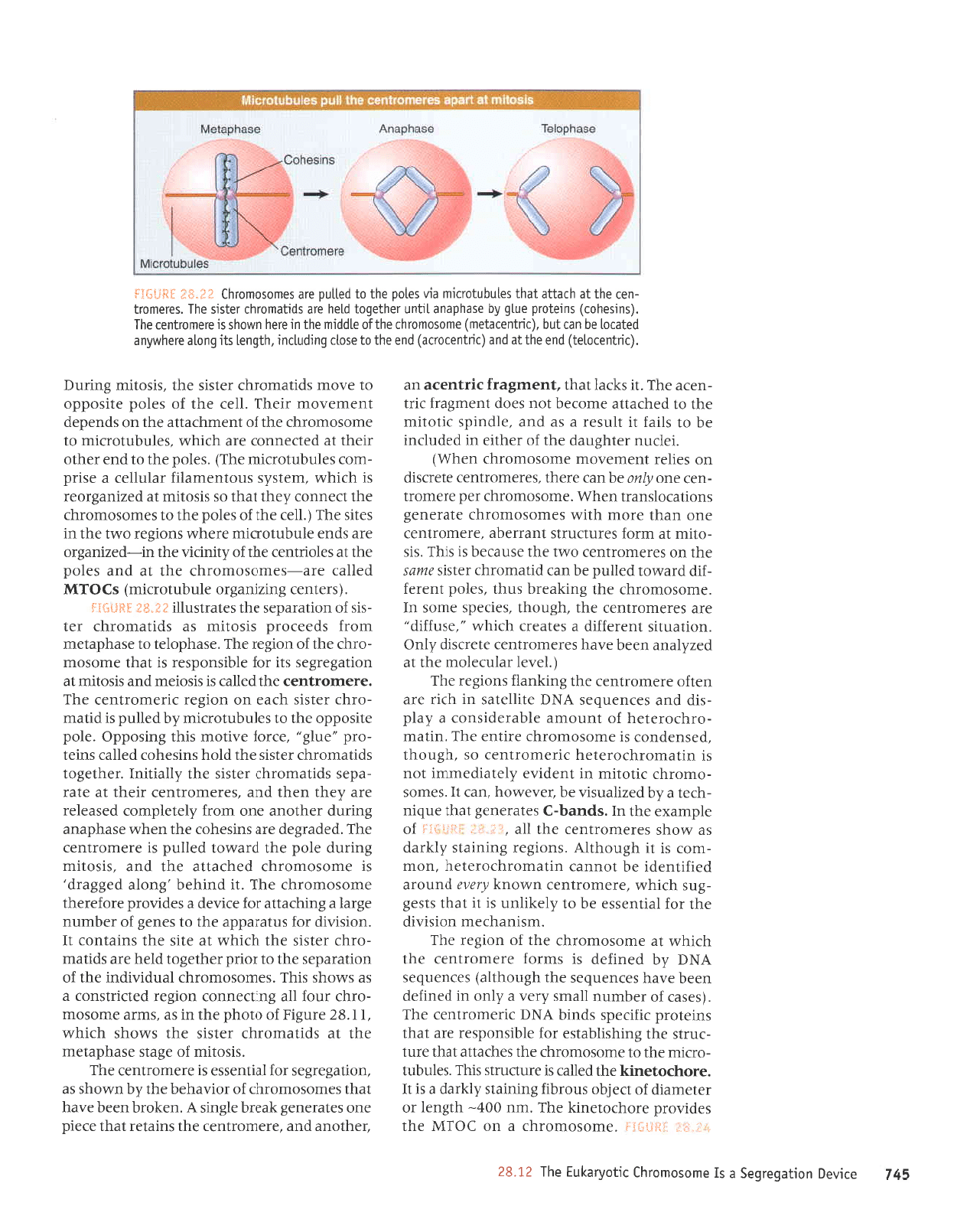
9'L
alnao
uoqe6al6as
e sI auosorxorq]
lqo^re)nl
aql
zI.gz
ri.j'i:ril
*i$il;lli"...j
'JIuoSoIuoJqJ
P
uo
fOIW
Jql
sJpr^oJd
aroqlolauDl
aqJ
'tuu
00t-
qfuel
ro
rJleuerp
Jo
lJefqo
snoJqrJ 3ururels,{1>IJep
e s1
t1
'eJoq)oleuDl
Jql
pJIIeJ
sr JJnpnJts srqJ
'selnqnl
-oJJrru
Jql
01 sruosotuoJqJ
Jql
saqJeile
lpql
eJnl
-JnJts
Jql Surqsrlqelsa
ro; alqrsuodsal aJp
tpql
suralord
lr;nads
spulq
vN11
trJeuoJlue) JqJ
'(saser
Jo
raqunu
lerus
,{ra.r
e ,{.1uo ur
peurJap
uJJq rlpq
saruanbas
aqr
q8noqtle)
saruanbas
vN11
^q pJurJap
sr sruroJ
JJaruortueJ eqt
qJIqM
lp
Jlrrosoruo[IJ
Jqt
;o
uor8ar aq1
'ursrueqJJru
uorsr^rp
Jql JoJ
Ielluassa
aq o1 ,{1aT1un
sr
1r leqt
slsa8
-8ns
qrrqrr
/aJeruoJluJf,
u,lrou>l [tau
punorc
pJIJrluJpr
aq
louueJ
urleruoJqf,oJetJr{
'uotu
-ruoJ
sr
1r
q8noqrly
'suor8ar
Sururels
,{prep
Se MOqS
SeJJtuOJluJ)
eql
IIe
'ir'i:
'iriri
iriiir,ri;j
JO
aldruexa
aql uI
'spupq-)
setpJJua8
leqt
anbru
-qlel
e ,{.q
pazuBnsm
Jq
'JJAaMoq 'up)
tI
'seuos
-ouorqf,
JIlotFu
ul
luJpr^J
,{laterpaurur
lou
sI
urleuorqJoJJlJq
JrJaruoJtuJr os
'q8noql
'pesuapuoJ
sr eurosouroJqJ
JJrluJ
aqJ
'urleu
-oJqJoJJlaq
Jo
lunorup
Jlqeraprsuor e ,(e1d
-srp
pue
saruanbas
VNO
alllleles ur
q)rJ
eJp
uJUo
JJJruoJluJJ
Jql Suplueg
suor8ar aq1
('le^el relnJslorr Jql
lP
pazLleue
ueaq aleq
seJJuroJtuJt
atansrp
r(p6
.UOI]ENIIS
1UJIJJJIP
P SJ]PJJ)
q]IqM
,,'ESNJJIP,,
JJE saJeruorlual
Jql
'q8noqr 'sanads
Jruos uI
'euosoruoJqr
aql
Surlealq
snql
'sa1od
tuara;
-JIp
pJeuot pa11nd
aq ue)
plteruoJqt
JJtsrs aluos
eql
uo seJauloJlueJ
oau Jql
JSneJeq sr srql
'srs
-olrru
lP
ruJo}
sJJnlJnJls
lUeJJJqe
'JJJrUOrlUaJ
euo ueql
eJoru
qlru
seruosouroJqr aleraua8
suollp)olsuprl
ueqM'eruosoruoJq:
rad araruorl
-uJJ
Juo [1uo aquet
JJeql'sJJeruor]ual JleJJsrp
uo sJrlJl
luJu.rJnoru
Jruosotuo;q: uaq14)
'IJpnu
rJtq8npp
eqt
Jo
JJqtrJ
ur
papnlJur
Jq
01 slrpJ
U
tlnsal
p
sp
pup
'alpurds
Jllolru
Jql 01
pJqrpne
aruoJaq
lou
saop
luaru8ery
rrrl
-uJ)p
JqI'lI s>lJel
leql
'luaruSeJJ
JlrluaJe
ue
tJqloup
pue
'erJruoJluJl
eqt surplar
leql
a;ard
euo seleJeue8 >1earq apurs
v
'uJ>loJq
uJJq J^eq
leqt
sJruosouorqJ
Jo
Jor^eqJq
aqt
r(q
uMoqs se
'uorle8a:8as
JoJ
Ierluessa
sr JJeruoJlueJ JqJ
'srsolrru
;o
a8els aseqdelaru
Jql
le
sprleruoJqJ Jalsrs Jql saoqs
qJlqill
'II'ge
arn8rg
Jo
otoqd
aql
uI
sp
'sruJe
atuosoru
-oJqJ
rnoJ
11e
Surpauuor uor8ar
palJrrlsuoJ
p
se sMoqs
srqJ
'sJrtrosoruoJq)
Ienpnpur
eql
Jo
uorleredas aql ol roud raqtaSol
plaq
eJe sprlpu
-oJqJ
Jelsrs eql
qJrr{A\
1e
Jlrs eql
sureluol
1I
'uorsrlrp
roJ snteredde aql ol sauaS;o Jeqrunu
a8rel e 8urqre11e JoJ JJrAep e sapnord JroJalaql
aruosouorqJ aql
'tl
pulqaq
,3uo1e
pa38erp,
sr JruosoruoJqJ
paq)el1e
aq1
puP
'srsolru
Surrnp alod aqt
pJpmol
pa11nd
sr alaruoJtuaJ
aq1'paper8ap ale sursJqoJ Jql uaqm aseqdeue
Surrnp Jeqloue auo ruoJ1
z[1a1a1duor peseeTaJ
are
,(aqt uaql
pue
'suJruoJluJJ
JrJql
le
aleJ
-edas
sprleruoJqJ Jelsrs aql
z(11er1ru1
'raq1a3o1
splleluoJq)
Jalsrs
eql
ploq
sursJqoJ
pallP)
surel
-ord
,,an13,,
'JJJoJ
alrtoru slqr Sursoddg
'a1od
alrsoddo aql 01 salnqnlor;rur,{q
pa11nd
sr
prleru
-orqJ
rJlsrs
qJee
uo uor8al JrJeIuoJlueJ JqJ
'ereruorlual
aql
pellel
sr srsoraur
puP
srsolrru
lP
uorle8ar8as
slr JoJ Jlqrsuodsar sr
ler{l
Jruosou
-orqJ
aqt
Jo
uor8a.r aq1
'aseqdolat
ol
aseqdelaru
ruoJJ speaJord srsolnu sp sprleruoJqJ Jal
-srs
Io
uorteredas eql sJlprlsnllr
Ie"*e ;ga{{':*g.j
'
(sraluar
SurzrueSro a1nqnloDrur) slO1,W
pJIIpl
JJe-sJurosoruoJqJ er{1
1e
pue
salod
aql
lp
salorJluar aql;o
dtIuIlIA aqt ul.-pazrue8ro
are spuJ elnqnloJJnu eJJqM suor8ar o,vt.l Jql ur
salrs aqJ
('lle)
rql;o salod Jq1 01 seuosoruorqr
Jq1
lJJuuoJ,{aqr leql
os sISolIIu
1e
pazrue8roar
sr
qJrqM
'rualsz(s
snoluJruElrJ JelnlleJ e asrrd
-ruoJ
selnqnloJJrru aq1)
'sa1od
Jqt ol
puJ
JJqlo
Jraql
]P
pelJJuuoJ
are
q)rqM
'sJlnqnloJJrru
01
aruosoruorqJ arp
Jo
luaruqlpile
Jqt uo spuadap
luJruJloru
JraqJ
'llal
eqt
Jo
salod
atrsoddo
01 Jloru
sprleruoJqJ Jelsrs eql
'srsolrur
Surrnq
'(ru1uaro1a1)
pua
oql
lp
pue
(ruluarone)
pua
aq1 ol asop 6urpnlour
'q16ue1
s1t 6uo1e etaqmfiue
palprol
eq
uer
1nq
'(ruluarelau)
auosotuolqr
aqlJo alppru aql ur alaq uMoqs sr
erauorlual aqf
'(suLsaqor)
suralord
en16
fiq
aseqdeue
lqun
reqlebol
ploq
alp sprlpuror.1l
lalsrs aql
'salauorl
-uer
aql
le
qrPDP
lPql
salnqnlolrrur
en saloo aql 01
palln0
erP seuosourorql
?:;j'*H
:s**ij
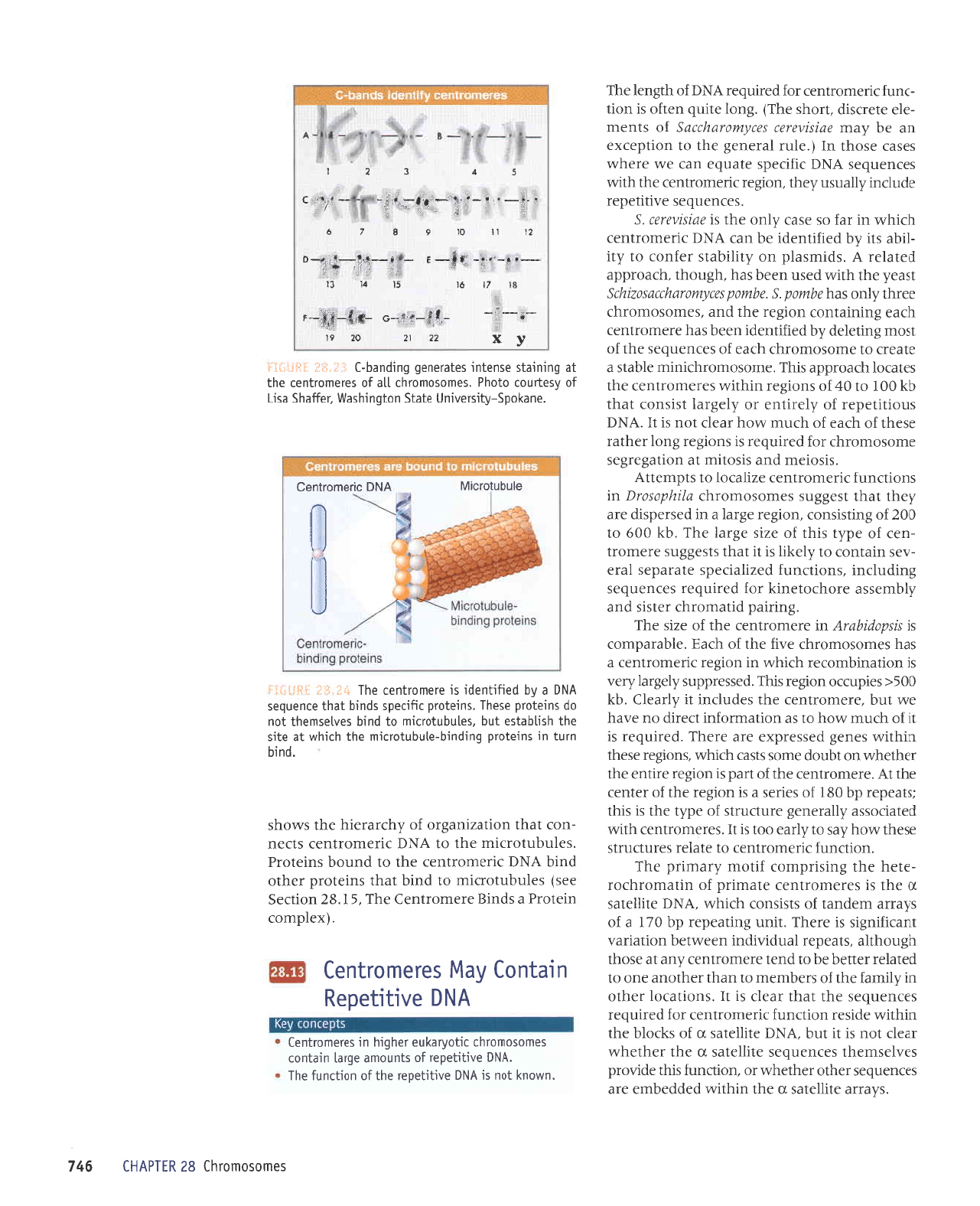
sstxosotuorql
8z
ulldvHl
gtrL
's^eJJe
JtlllJtes
n
eql urquM
papp3qruJ
ere
sef,uJnbes reqlo Jeqlar{M ro
'uorDunJ
slql
aphord
se^IJsrueql sa)uJnbes alrlleles
D
eql JeqleqM
rerlJ
lou
sr
1r
tnq
'vNo
allllJlPs
n
Jo
s>lrolq rqr
urqlrM JprsaJ uorl)unJ JrJeurorluJ) roJ
pJJtnbJr
saluanbJs
er{]
leq]
reJIf, sr
1I
'suorle)ol
laqlo
ur
^IIIUPJ
aql
Jo
sJeqtuelu ot ueql JJqloup Juo ol
pJlplJr
retleq eq ot
puJl
JrJuroJluJJ
,{ue
te
asoql
q8noqlle'slpJdJr
lenprlrpur
uJJMtaq uouprrpn
luerr;ru8rs
sr JJJr{J
'tlun
Suueadar dq
911
e;o
sLerre
rurpuet
Io
slslsuoJ qJIqM
'VNC
JtlllJles
n
aql sI sJJaurortueJ aleruud
Jo
uupuo-rqJor
-JtJr{
aql Sursrrduror
Jrtou
zfuprurrd
aq;
'uoIl)unI
JrrJuroJluer o1 aIPIJJ sernlJnJls
eseql Moq .{.es ol Lgea
oot sr
U
'sJJJruonuJ)
qtrM
petprJosse
Lleraua8
JJnt)nJls
1o
ad,{1 aqt sr srqt
lsteadar
dq
OS t
Jo
seuas e sr uor8ar Jqt
Jo
JatuaJ
eql
1v
'JJJruorluJJ
aqt;o
ued
sr uorSar JrrtuJ eql
rJqlaqM uo
lqnop
Jruos slsp)
qJnJM
'suor8ar
asaql
urqlr.&\ saua8
passardxa
are araql
'parrnbar
sr
1l
IO
q)nu
.&{oq
ol se uorlPruJoJul
lJJrrp
ou JAPLI
e,lt
lnq
'JJeLuoJlueJ
Jqr sJpnlJur
t1
.{pea13
'q1
ggg<
sardnrro uorSar snIJ'passarddns Lla8rel
fua.t
sI uolleulqluof,ar
qJrqM
ur uor8ar JrJJruorJuJJ
p
seq seuosoruoJqJ eArJ
Jqt
]o
qJeg
'alqereduor
x sndoptqaty ur JJeruoJlual eqt
Jo
JZrs eqJ
'Surrred
ppeuoJql
JJlsrs
pue
z(lqruasse JJoqrotJur>l
ro;
palnbar
saruanbas
Surpnpur
'suorlJunJ
pazqenads
ateredas
lera
-AJS
urpluo)
ot
^IJIII
sr
1r teqt
stsaSSns aJauroJl
-uJ)
Jo
adLl srql
Jo
ezrs a8rel aq1
'q{
009
<l1
002
Jo
Sutlslsuor
'uot8al
a8rel e ut
pasradstp
are
,daqt
reqr tsaSSns
sauroso[rorqt altqdosotq
ur
suorlJunJ )ueLUoJluJ) JZllp)ol
ot stduatty
'srsorJur
pue
srsolnu
le
uorle8ar8as
aurosoruoJqr ro;
patrnbar
sr suor8ar 3uo1 raqler
asJql
Jo
qJee
Jo
qlnu
.&\oq
reJp
lou
sl
1I
'vN(I
snortrtadar
;o
L1a.n1ua
ro .{.1a8re1
tsrsuo) teql
q{
00I
ot
0t
}o
suor8ar urqtrM
sarauonue) aql
sat€Jol
qreordde
srqJ'eurosotuoJqJrurur
Jlqets e
eleerJ ol eurosoruorqJ qJpJ
;o
sa;uanbas Jql
Jo
lsoru
Surlalap
,{.q paryluapr
ueeq spq aJJuroJtuJf,
qrea
Surureluor
uorBa.r Jr{l
pup
'sJruosotuoJqJ
aarql
r(po
seq a
qtuo
d'
g'
a
qwo
d s at
[tu1
Ja
qng
s 'ztLp
S
1sea.d
aqt
qrlu pasn
uaJq
seq
'q8noqr 'qreordde
petelJJ
y
'sptuseld
uo ,,(1r1rqe1s
raJuor ol ^dlr
-llqe
sll Lq
parptuapr
aq ueJ
yNO
rrrrruorlurJ
qJIqM
ur reJ os aser
Aluo Jqt s ao$aaln
'S
'saruanbas
anrlrladar
apnprn Llensn Laql
'uot8ar
rFauoJtuJJ
Jql
qtl
{
saruanbas
y51q
rr;oads alenba
upJ a,r,r arJr{,,lr
sJSeJ esoql u1
('a1nr
leraua8
aql ol uorldJJXJ
ue aq Aeut
aatsttatat sac[wota4nas
lo
slueur
-ale
etansrp
'goqs
aql)
'3uo1
atrnb uJUo sr uorl
-f,un;
JrJeruoJtual roJ
peJrnbar ypq;o
43ua1
aq1
'uMoul
lou
sr
vNo
a^qrlaoer
oqlJo uotllunJ aql
'y116
anrlrlada.l
Jo
slunoup a6.re1
uteluor
sauosouroiql rrloAre>1na
raqbtq uL salaurollual
vN0
a^llqadau
ut Pluol Aeyl sareuorlual
'(xalduor
urJloJd e spurg araruortuJJ
eqJ
'E
I'82
uolDaS
aas) salnqntorJrur 01
purq
teqt
suralord raqlo
pulq
vN(I
JrJaruoJlual
Jq1 01
punoq
sulalord
'sJlnqnloJf,rru
Jq1 01
vNC
)rJaurorlueJ
slJJu
-uoJ
teql
uoltezrue3ro;o
Lqrreratq eql smoqs
'pulq
urnJ ur suralo.ld 6urpuLq-alnqnlollrul
aql
qltqM
lp
alts
aql
qsllqelso
lnq
'salnqnlolltul
ol
putq
so^lasuaql
10u
op suralord asaql
'suLalord
rgLrads sputq
lpql
aluanbes
VN0
e
fq
palJquapr
sr ereurollual aqf
;:'I'.r:i. -t$i::.t:-i
'aue1od5-fi1rsra^run
alpls uol6uLqse6
laJJpqS
pstl
1o
fselnor
oloqd
'soulosotuorql
lle Jo
sereuolluel aql
1e
6uLurels osualur saleraue6
6uLpueq-3
l;l':iij
rjiiiti,lLJ
t]
N
olnqnlorcrl/\
vNo
cueuoiluec
dxz(.rz0z6r
-'-- -
-
ri-'
"-c
-l
'-f'f
-r
8r
lt
9r
st tt
cl
.,i .;
-r,$-",
{-
.l*$-
I
-
;--i;,g---f;r'r1o
zl It 0r
6
I I
9
;
,
,i-.'r
-;.['*'tfJ',11i-
--
,li, r
9rE7,
l
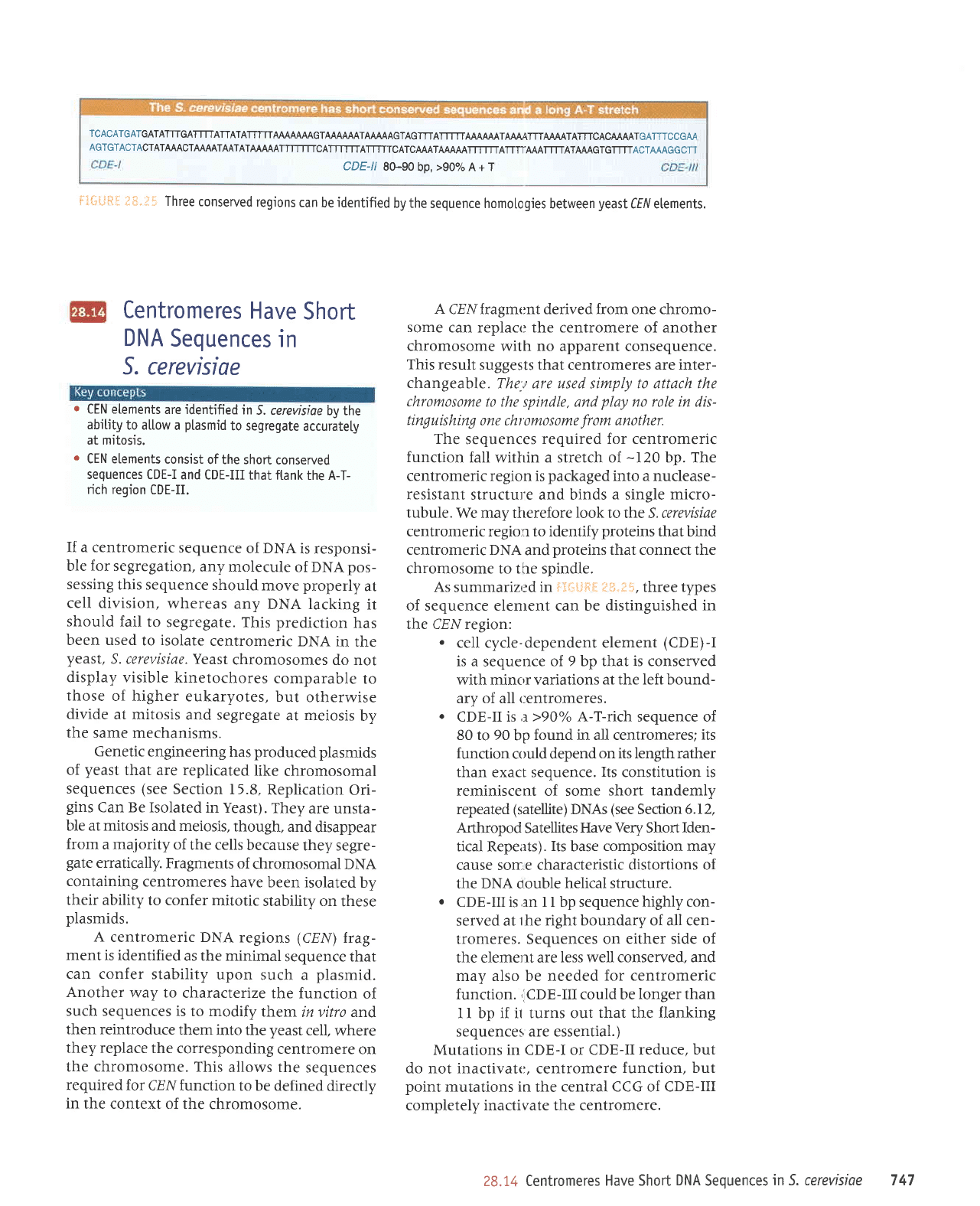
TCACATGATGATATTTGATTTTATTATATTTTTAMMMGTAAAAAATAAAAAGTAGTTTATTTTTAAMMTAMAT]-TAAMTATTTCACMMTGATTTCCGAA
AGTGTACTACTATAAACTMAATAATATAAMATTTTTTTCATTTTTTATTTTTCATCAAATAAAMTTTTTTATTTTMATTTTATAAAGTGTTTTACTAAAGGCTT
CDE-ll
8O-9O
bo.
>90%
A + T
l:Gil5iltS.il
ThreeconseryedregionscanbeidentifiedbythesequencehomotogiesbetweenyeastCE/Vetements.
Centromeres
Have
Short
DNA
Sequences
in
S.
cerevisiae
r
CEN etements
are identified
in
5. cerevisiae
bu the
abitity
to al.l.ow
a
ptasmid
to segregate
accuritety
at mitosis.
o
CEN etements
consist
of the short
conserved
sequences
CDE-I and
CDE-III that ftank
the A-T-
rich region
CDE-II.
If a centromeric
sequence
of DNA
is responsi-
ble for segregation,
any molecule
of DNA
pos-
sessing
this sequence
should
move
properly
at
cell division,
whereas
any
DNA lacking
it
should
fail to
segregate.
This
prediction
has
been used
to
isolate
centromeric
DNA in
the
yeast,
S. cerevisiae. Yeast
chromosomes
do not
display visible
kinetochores
comparable
to
those
of higher
eukaryotes,
but
otherwise
divide
at mitosis
and segregate
at meiosis
by
the
same mechanisms.
Genetic
engineering
has
produced
plasmids
of
yeast
that are
replicated
like
chromosomal
sequences
(see
Section 15.8,
Replication
Ori-
gins
Can Be Isolated
in Yeast).
They
are unsta-
ble at mitosis
and meiosis,
though,
and
disappear
from
a majority
of the cells
because
they segre-
gate
erratically.
Fragments
of
chromosomal
DNA
containing
centromeres
have
been isolated
by
their ability
to confer
mitotic
stability on
these
plasmids.
A
centromeric DNA
regions (CEN)
frag-
ment
is identified
as the minimal
sequence that
can confer
stability
upon
such a
plasmid.
Another
way to
characterize
the function
of
such sequences
is to modify
tlnelriL
in vitro and
then reintroduce
them
into the
yeast
cell,
where
they replace
the
corresponding
centromere
on
the chromosome.
This
allows the
sequences
required for
CENfunction
to be defined
directly
in
the context of the
chromosome.
A
CENfragmt:nt derived from one chromo-
some
can replact: the centromere of another
chromosome
with no apparent consequence.
This
result suggests that centromeres are inter-
changeable
. Thel are used simply to attach the
chromosome
to the spindle, and
play
no role in dis-
tinguishing
one
chromosome
from
another.
The
sequences
required for centromeric
function
fall within a stretch of
-I20
bp. The
centromeric region is
packaged
into a nuclease-
resistant
structure and binds
a
single
micro-
tubule.
We may ttrerefore
look
to the S. cerevisiae
centromeric regio.c to identify
proteins
that bind
centromeric DNA
and
proteins
that connect the
chromosome to the spindle.
As
summarizr:d
in i'3{*:i"ifif,:,
'J*.JS,
three types
of sequence elenrent can be distinguished
in
the CEN region:
.
cell cycle-dependent element
(CDE)-I
is a
sequence
of 9 bp that
is
conserved
with minc,r variations
at the left bound-
ary of all centromeres.
o
CDE-II is
,t >90o/o
A-T-rich sequence of
80 to 90
bp
found in all centromeres;
its
function
could depend
on its Iength rather
than exact sequence.
Its
constitution
is
reminiscent of some
short tandemly
repeated
(satellite)
DNAs
(see
Section
6.I2,
Arthropod
Satellites
Have Very Short Iden-
tical Repe;rts).
Its
base
composition may
Cduse SorrLe characteristic
distortions of
the DNA oouble
helical structure.
.
CDE-III isan I I bp sequence
highly
con-
served at
the right boundary of all cen-
tromeres. Sequences
on either side of
the element are
less well conserved, and
may also be needed
for centromeric
function.
:CDE-III
could be
longer than
I I bp if il turns out
that the flanking
sequences are essential.)
Mutations in CDE-I or CDE-II
reduce, but
do not inactivatt:,
centromere
function, but
point
mutations
in
the
central CCG of CDE-III
completely inactivate the centromere.
28.14 Centromeres
Have Short
DNA
Sequences
in S. cerevisioe 747
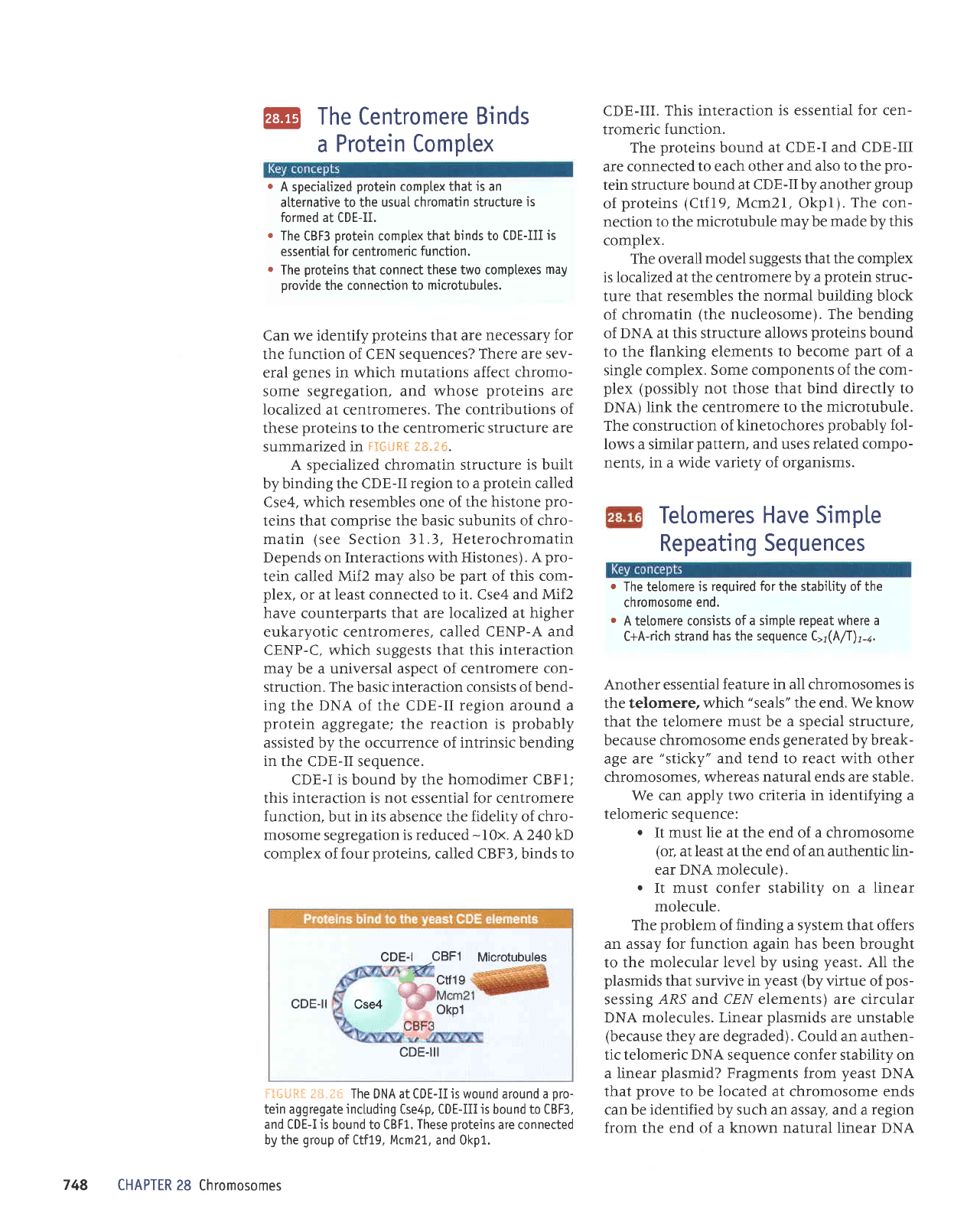
a
Protein Complex
@
The Centromere
Binds
.
A specialized
protein
comptex that
is
an
atternative to the
usuaI chromatin structure
is
formed at
CDE-IL
r
The
CBF3
protein
comptex
that binds to CDE-III
is
essentiaI
for
centromeric
function.
.
The
proteins
that connect
these two comptexes
may
provide
the connection to
microtubules.
Can
we
identify
proteins
that are
necessary for
the
function
of CEN sequences?
There are
sev-
eral
genes
in which
mutations affect chromo-
some segregation,
and whose
proteins
are
localized at centromeres.
The contributions of
these
proteins
to the centromeric
structure are
summarized in
FISUftE I8.tS.
A
specialized
chromatin structure
is built
by binding the CDE-II
region to a
protein
called
Cse4,
which resembles one of the histone
pro-
teins that comprise the basic subunits
of chro-
matin
(see
Section 3I.3, Heterochromatin
Depends
on
Interactions with Histones).
A
pro-
tein called Mif2
may
also be
part
of
this com-
plex,
or at least connected to
it.
Cse4 and
Mif2
have
counterparts
that are localized at higher
eukaryotic centromeres, called CENP-A
and
CENP-C, which suggests that this
interaction
may be a universal aspect of centromere
con-
struction. The
basic
interaction consists of bend-
ing
the DNA of the CDE-II
region arounci a
protein
aggregate; the reaction is
probably
assisted
by the occurrence
of intrinsic bending
in
the CDE-II sequence.
CDE-I is bound by the
homodimer
CBFI;
this interaction
is
not essential
for
centromere
function, but in its absence the fidelity of chro-
mosome
segregation
is reduced
-10x.
A 240 kD
complex of four
proteins,
called CBF3, binds to
CDE-I CBFl
Microtubules
cDE-rl Cse4
ctf19
Okpl
cDE-il1
f3t:iifi[
tii, t$ The DNA at CDE-II
'is
wound around a
pro-
tein aggregate including
Cse4p, CDE-III
is
bound to CBF3,
and
CDE-I
is
bound to CBF1.
These
oroteins are connected
by the
group
of Ctf19, Mcm21,
and Okp1.
CHAPTER 28
Chromosomes
CDE-III.
This interaction
is essential for cen-
tromeric
function.
The
proteins
bound
at CDE-I and CDE-III
are connected
to each other
and also to the
pro-
tein structure bound
at CDE-II by another
group
of
proteins
(Ctf
19, Mcm2l, Okpl).
The
con-
nection
to the microtubule
mav be made bv this
complex.
The overall
model suggests that the complex
is localized
at the centromere
by a
protein
struc-
ture
that resembles
the normal building block
of chromatin
(the
nucleosome).
The bending
of
DNA at this structure
allows
proteins
bound
to the
flanking elements
to
become
part
of a
single complex.
Some components of the com-
plex (possibly
not those
that bind directly to
DNA) link the centromere
to the microtubule.
The construction
of kinetochores
probably
fol-
lows a similar
pattern,
and uses related compo-
nents,
in a wide variety of organisms.
Telomeres
Have Simple
Repeating
Sequences
o
The telomere is
required for the stability of the
chromosome
end.
r
A tetomere consists
of a simple repeat where a
C+A-rich strand
has the sequence C1(A/I)L4.
Another essential feature
in all
chromosomes
is
the telomere,
which
"seals"
the end. We
know
that the telomere
must
be
a special structure,
because
chromosome ends
generated
by break-
age are
"sticky"
and tend to react with other
chromosomes, whereas
natural ends are stable.
We can apply
two criteria in identifying a
telomeric sequence:
.
It must lie at the end of
a
chromosome
(or,
at least at the end of an authentic lin-
ear DNA molecule).
.
It must confer stability on a linear
molecule.
The
problem
of finding a system that offers
an assay for function again
has
been brought
to the
molecular level by using
yeast.
All the
plasmids
that
survive
in
yeast
(by
virtue
of
pos-
sessing
ARS and CEN elements) are
circular
DNA
molecules. Linear
plasmids
are unstable
(because
they are degraded). Could an authen-
tic telomeric DNA sequence confer stability on
a Iinear
plasmid?
Fragments from
yeast
DNA
that
prove
to be located at chromosome ends
can be identified by such an assay, and a region
from
the end of
a known natural linear DNA
748
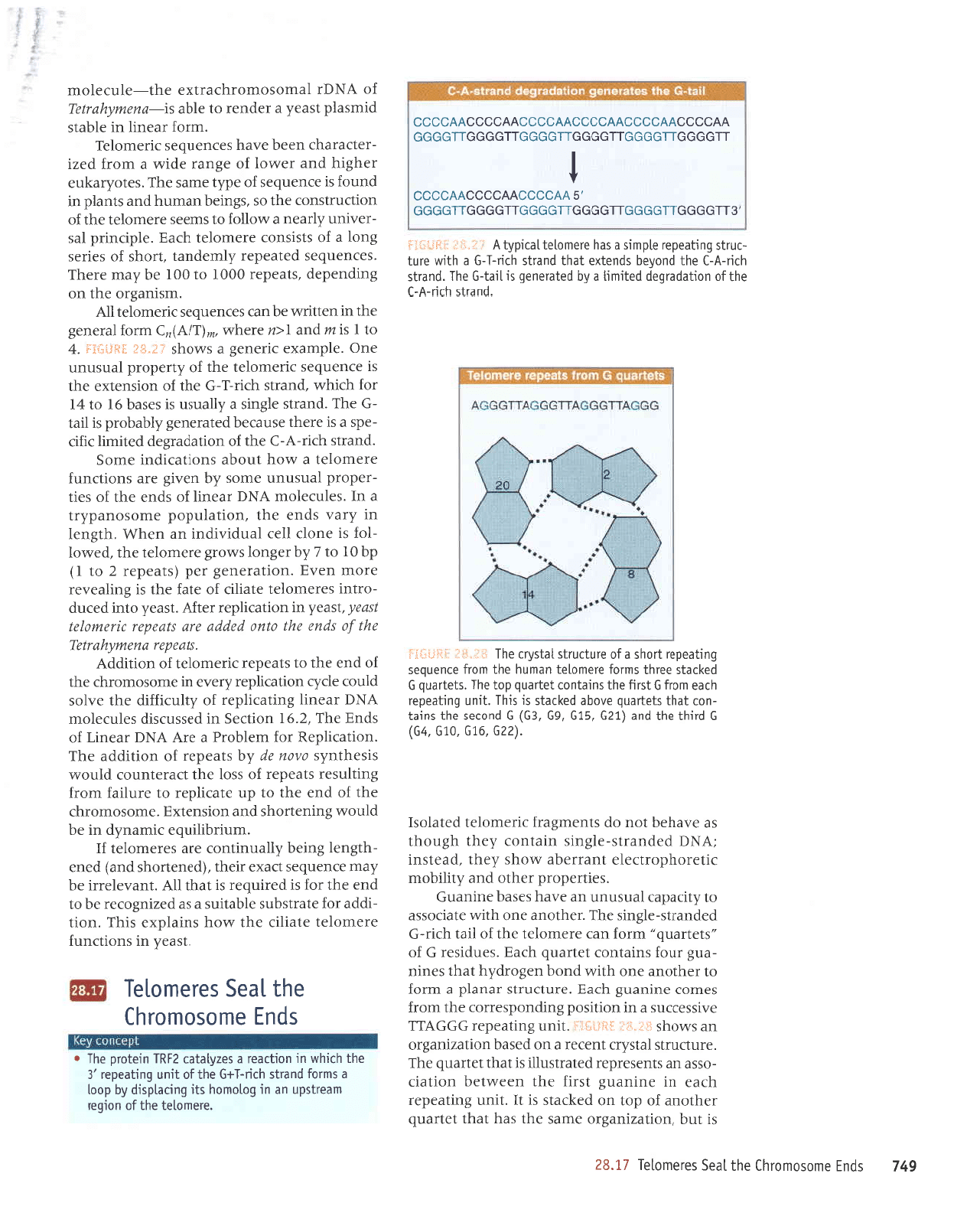
6'L
spul auosoruolll
eql
lpas
sslaulolal
/I'gz
sr
lnq
'uorlpzrupSJo
elues Jql seq
]eq]
lJuenb
JJqtoue
Jo
dol uo
pJ>llels
sl
U
'lrun
Sulleadar
qleJ
ur auruen8
lsrrJ
eql uJJMtJq uorlprf,
-osse
ue sluasardar
peteJtsnllr
s1
leqt lauenb
aq;
'eJnDnJls
Iels^JJ
lue)Jr
e uo
peseq
uorlezrue8ro
uP
sMoqs
i:;l"ijl
:ir-Jltli"*
'lrun
SurteadJr
)99vJJ
JAISSeJJns e ur
uorlrsod SurpuodsarroJ Jql uorJ
sJruo)
euruen8
qJpg
'JrnlJnrls
teueld
p
ruJo}
01 rJqtoup
Juo
qlrM
puoq
uaSorpdq
teqt
sauru
-en8
rnoy suretuo)
lalrenb
qJeE
'sanprsal
g
Jo
,,stalrenb,,
ruJoJ uef, eraruolJt
eqt
Jo Iret
r{JIr-g
papuens-a13urs
JqJ'Jeqtoue euo
qtrM
ater)osse
o1 zi.lneder
Ipnsnun
ue JAeq sJseq Jurueng
'sartradord
JJqlo
pue
Llgrqou
rrla;oqdorllJIe
tueJJaqp
Moqs .daqr
'pealsur
IVNC pJpuerls-a13urs
uretuof, .{aql
q8noqr
se eneqJq
tou
op stuaru8er; JrJJruolal
pJtplosl
'(zz,l'gt'l
'ot9'tD)
!
prlqt
aqt
pup
(IZ9
'gI9 '69 'Eg)
9
puoras
aq] surel
-uor
leql
stalpnb a^oqe
pa)lpls
st srql
'lrun
6uLleadar
qlea
uor1
g
lsrg
aql sureluol
1a1enb
do1 aql
's1a1renb
9
pa)rPls
aarql suroJ
alauolal uPUnq oql urorJ oluenDos
6urleeder
iloqs
e
Jo
elnllnrls
1e1sfur
aq1
'
-
,.-'':rIt
'puells
qru-v-l
aql
Jo
uoqpperbap
palruq
e Aq
paleraua6
sl
llpl-g
aql
'puerls
r..ll!l-V-l
aq1
puofaq
spuolxa
leql
puplls qr!-l-g
e
qlrM
o.lnl
-rnr1s
6ugeadar aldrLLrs
e seq aloulolollprrdfil
y
.1
r,"ri;,
iijir:jij
'araur0l0l
aql
Jo
uorDa.l
ueallsdn ue
ur Eolouoq s1r Durreldstp
r\q dool
e suuoJ
puerls qru-I+g
aql
Jo
ltun
butleadat
,g
aql
qlrqM
ur
uorllPal e sazr\1e1er
7351
utelord aq1
r
spul auosoruorql
oql
lPas
sarauolal
'lsee^
uI suollf,unJ
eJeuolJt
Jtprlr) aql
,lroq sureldxa srqJ
'uoll
-rppp
roJ alertsqns
elqellns
e se
pazruSo)eJ
eq 01
puJ
aql ro; st
parmbal
sI
lpqt
IIV
'tuelelaJJl
Jq
,{eru aruanbas
tJexe
rtaqr
'(paual.roqs
pue) paua
-er8ual
Sutaq
Lllenulluo) ale sJrJruolJt
JI
'runrrqllnba
rtueuLp
ut aq
plnoM
Suruagoqs
pue
uorsuelxg'eruosouorql
eql
Jo
pua
Jqt o1 dn alerqdJJ
ol aJnlIeJ uoJJ
Surlpsar sleadar
Jo
ssol eql
t)eJJtunoJ
plnoM
srsaqlur(s
0^0u ap
dq sleadar
io
uolllppP
JqJ
'uor1er11dag
JoJ
tuJlqord e arv
vNO
reaulf
Jo
spug JqJ'z'9I
uolDes uI
pJssnlslp
selnJelolu
VN(
reJurl 3u1terr1da.r
yo z(rlntlyytp Jql anlos
plnor
apLr uorle)qdeJ
z(rana ur auosoruoJqJ
eql
Jo
pua
aql
ot slpedeJ JlrJruolal
Jo
uouppy
'
s10 a aa J
0
u 2u1nt4t2 Jl 2J
2tl1
l0
spua a41 01u0
pappa
2fi svadat
)uau.I)lal
$a
a ['
lsea
tr
ur
uorlerrldal JeqV'tsea^
olut
pa)np
-oJlur
saJeurolel
elpIIIJ
Jo
eleJ
Jqt sI SuIIeJ^er
eJorrr
uJAf
'uorteraua8
Jad
(slpJdeJ
Z
ot
I)
dq
g1
or
1
.{.q ra8uol sa,ror8
Jreruolet
rqt
'prmol
-lo;
sr JuolJ
IIJr Ienpl^rpur
up uJqM
'qlSuJI
ur Lre.t spue
aql
'uorlelndod
aruosouedz(rl
e uI
'sJlnJaloru
vN(I
TPJUII
Jo
spue aql
Jo
sall
-radord
Iensnun
atuos
Lq uaat8
are suollJunJ
JJJruOIel P
A\oq
lnoqe
suolleJlpul
aluos
'puens
q)Ir-V-)
eql
Io
uoueper8ap
palnu11
rr;o
-ads
e st JJeqt
JSneJaq
paleraua8 Llqeqord st
pet
-g
rql
'pupJts
a13urs
e
.{.1ensn sI seseq
9I
ot
VI
roJ
qJrqM'pueJls
q)lr-J-D
aql
Io
uolsusxe eql
sr aluanbas
JrJaruolal
aqr
Jo
.drradord
lensnun
aug
'aldruexa
rtraua8
e sMoqs
J-,-y'fifr ii4ll{i3;l
'7
ot
I
slLupue
l<u
eraqM
'*(yV)")
ru:o;
praua8
Jqt
ur uJlltJ,t,r
aq up) satuenbas:tlJtuo^lJl
IIV
'ursruebro
aql uo
Surpuadap
'sleadar
000I
ol
00I
eq
u(eru araql
'saruanbas
pateadar
,,iluapuer
'uoqs
Jo
sJlles
3uo1
e
Jo
slsrsuof,
JrJruolat
qreg
'aldtrutrd
ps
-relrun
l.peau e
MolloJ 01 sureJs
JJauolal Jql
Jo
uortJnJtsuof,
aq1 os
's8utaq
upunq
pue
s1ue1d ut
punoJ
sr aruanbas
1o
adz(1 arues
aqJ'salodropa
raqSrq
pue
JaMol
;o
a8uer JpIM
e IxoJJ
pJZI
-JJIJprpq)
uJJq J^eq
saruanbas
JIJJLUoI{
'rrrJoJ
JeJUII
uI Jlqels
prruseld
lsea.d
e
rJpueJ ot
JIqP x-auawfu4a4a1
Jo
vN(J
IeluosoruoJq)eJlxJ
Jql-elnJJlour
, etr900eilo090[eeeetl9999r_]e999rr9999
,9
VVCCCCWSCCCVVCCCC
+
I
Il-099C[00e
0!_0e 0e!_9e 99]r0e e e!-e
999
vvccccvvc9ccvvccccvvccccvvccccvvcccc
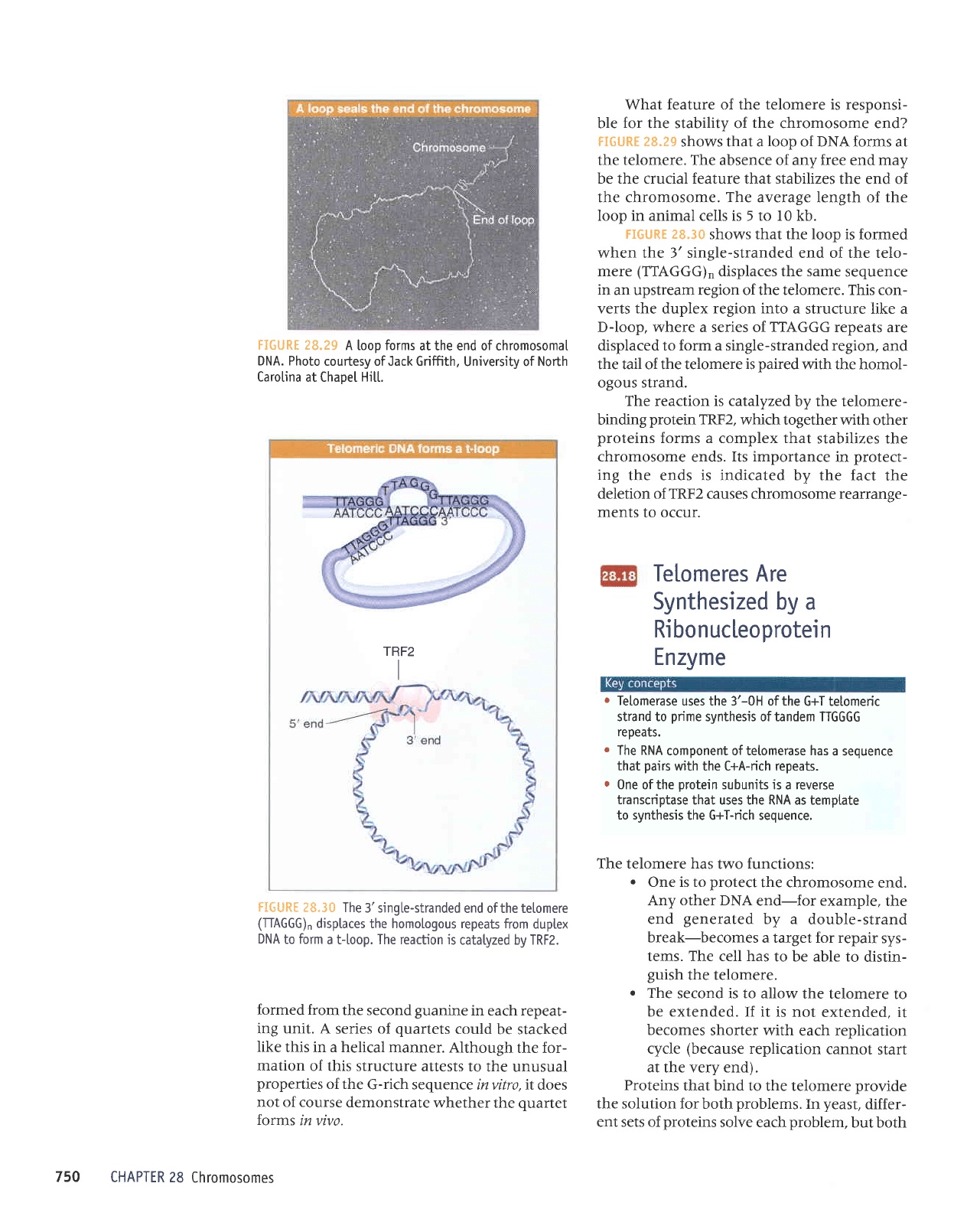
FIGURE 28.29
A loop forms
at the end of chromosomal
DNA. Photo
courtesy ofJack Griffith,
University of
North
Carolina
at Chaoel Hilt.
What feature of the telomere is responsi-
ble
for
the stability of
the
chromosome end?
FIGURE 28.29
shows that a
loop
of DNA forms at
the telomere. The absence of any free end may
be the crucial feature that stabilizes
the end of
the chromosome. The average length of the
loop in animal cells is 5 to l0 kb.
FIGURE
28,30
shows that the loop is
formed
when the 3' single-stranded end of the telo-
mere
(TTAGGG)"
displaces the same
sequence
in
an upstream region of the telomere. This con-
verts the
duplex
region into
a structure like a
D-loop, where a series of TTAGGG repeats
are
displaced to form a single-stranded region,
and
the tail of the telomere
is
naired with the homol-
ogous strand.
The reaction is catalyzed
by the telomere-
binding
protein
TRF2, which together with
other
proteins
forms a complex that
stabilizes the
chromosome
ends.
Its importance
in
protect-
ing
the ends is indicated by the fact
the
deletion of TRF2 causes chromosome
rearrange-
ments
to occur.
TRF2
FIGURF
?8.30 The
3'single-stranded
end ofthe tetomere
(TTAGGG)"
disptaces
the homologous repeats from
duplex
DNA
to form
a t-[oop. The reaction is
catatyzed by TRF2.
formed from
the second
guanine
in
each
repeat-
ing unit.
A series of
quartets
could
be stacked
Iike
this in a helical
manner. Although
the for-
mation
of this structure
attests to
the unusual
properties
of the
G-rich sequence
invitro, it does
not of course
demonstrate whether
the
ouartet
forms
in vivo.
Chromosomes
Te[omeres
Are
Synthesized by a
Ribonucleoprotein
Enzyme
o
Telomerase
uses the 3'-0H ofthe
G+T telomeric
strand to
prime
synthesis of tandem TTGGGG
reDeats.
o
The RNA
component of tetomerase has
a sequence
that
pairs
with the C+A-rich repeats.
r
One of the
protein
subunits is
a
reverse
transcriptase
that uses the RNA as temptate
to synthesis
the G+T-rich sequence.
The telomere has
two
functions:
.
One is to
protect
the chromosome
end.
Any other DNA
end-for example,
the
end
generated
by a
double-strand
break-becomes
a target for repair
sys-
tems. The cell has
to be able to
distin-
guish
the telomere.
.
The
second is to allow
the telomere
to
be extended.
If it is not
extended, it
becomes
shorter with
each replication
cycle
(because
replication
cannot start
at the very end).
Proteins
that bind to
the telomere
provide
the solution for
both
problems.
In
yeast,
differ-
ent sets of
proteins
solve each
problem,
but both
750
CHAPTER 28
